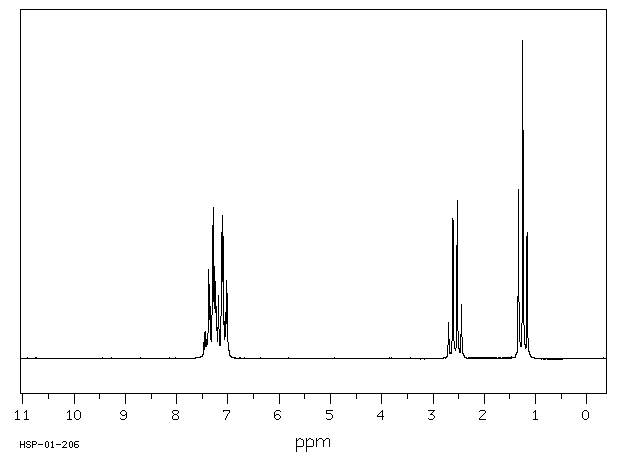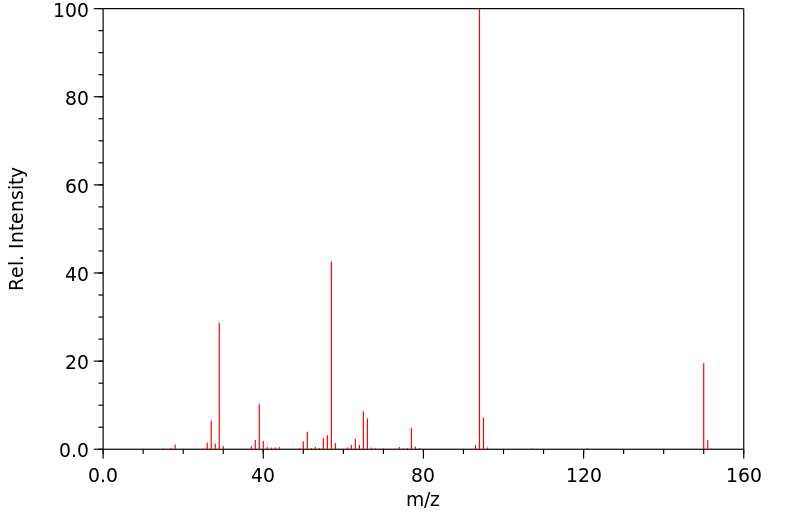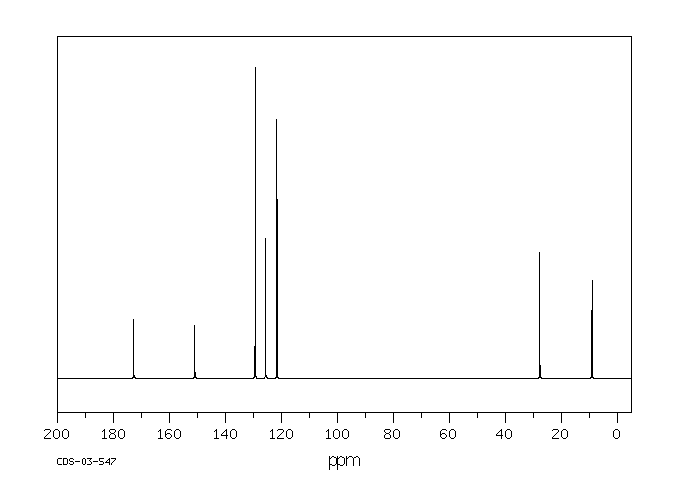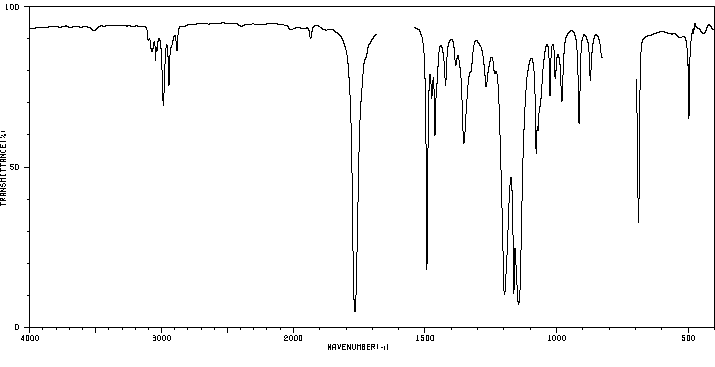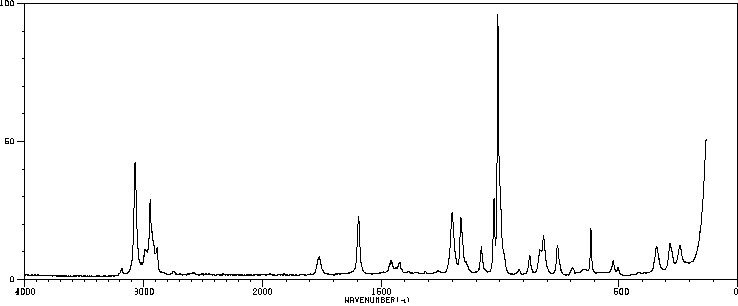苯丙酸去甲睾酮 | 637-27-4
中文名称
苯丙酸去甲睾酮
中文别名
丙酸苯酯
英文名称
phenyl propionate
英文别名
phenyl propanoate;methyl phenylacetate;propanoic acid phenyl ester
CAS
637-27-4
化学式
C9H10O2
mdl
MFCD00053765
分子量
150.177
InChiKey
DYUMLJSJISTVPV-UHFFFAOYSA-N
BEILSTEIN
——
EINECS
——
-
物化性质
-
计算性质
-
ADMET
-
安全信息
-
SDS
-
制备方法与用途
-
上下游信息
-
文献信息
-
表征谱图
-
同类化合物
-
相关功能分类
-
相关结构分类
物化性质
-
熔点:20°C
-
沸点:211°C
-
密度:1,05 g/cm3
-
闪点:86°C(lit.)
-
LogP:2.08
-
保留指数:1151
-
稳定性/保质期:
远离氧化物、光线、热量、明火和高温。
计算性质
-
辛醇/水分配系数(LogP):2
-
重原子数:11
-
可旋转键数:3
-
环数:1.0
-
sp3杂化的碳原子比例:0.222
-
拓扑面积:26.3
-
氢给体数:0
-
氢受体数:2
安全信息
-
安全说明:S23,S24/25
-
海关编码:2915509000
-
WGK Germany:3
-
储存条件:存放在密封容器中,并置于阴凉、干燥处,室温下避光保存。储存位置需远离氧化剂。
SDS
Section I.Chemical Product and Company Identification
Chemical Name Propionic Acid Phenyl Ester
Portland OR
Synonym Phenyl Propionate
Chemical Formula CH3CH2COOC6H5
CAS Number 637-27-4
Section II. Composition and Information on Ingredients
Chemical Name CAS Number Percent (%) TLV/PEL Toxicology Data
Propionic Acid Phenyl Ester 637-27-4 Min. 95.0 Not available. Not available.
(GC)
Section III. Hazards Identification
Acute Health Effects No specific information is available in our data base regarding the toxic effects of this material for humans. However,
exposure to any chemical should be kept to a minimum. Skin and eye contact may result in irritation. May be harmful if
inhaled or ingested. Always follow safe industrial hygiene practices and wear proper protective equipment when handling
this compound.
CARCINOGENIC EFFECTS : Not available.
Chronic Health Effects
MUTAGENIC EFFECTS : Not available.
TERATOGENIC EFFECTS : Not available.
DEVELOPMENTAL TOXICITY: Not available.
There is no known effect from chronic exposure to this product. Repeated or prolonged exposure to this compound is
not known to aggravate existing medical conditions.
Section IV. First Aid Measures
Eye Contact Check for and remove any contact lenses. IMMEDIATELY flush eyes with runing water for at least 15 minutes. keeping
eyelids open. COLD water may be used. DO NOT use an eye oitment. Flush eyes with running water for a minimum of
15 minutes, occasionally lifting the upper eyelids. Seek medical attention. Treat symptomatically and supportively.
Skin Contact After contact with skin, wash immediately with plenty of water. Gently and thorough wash the contaminated skin with
running water and non-abrasive soap. Be particularly careful to clean folds, crevices, creases and groin. COLD water
may be used. Cover the irritated skin with an emollient. Seek medical attention. Treat symptomatically and supportively.
Wash any contaminated clothing before reusing.
Inhalation If the victim is not breathing, perform mouth-to-mouth resuscitation. Loosen tight clothing such as a collar, tie, belt or
waistband. If breathing is difficult, oxygen can be administered. Seek medical attention if respiration problems do not
improve.
Ingestion INDUCE VOMITING by sticking finger in throat. Lower the head so that the vomit will not reenter the mouth and throat.
Loosen tight clothing such as a collar, tie, belt or waistband. If the victim is not breathing, perform mouth-to-mouth
resuscitation. Examine the lips and mouth to ascertain whether the tissues are damaged, a possible indication that the
toxic material was ingested; the absence of such signs, however, is not conclusive. SEEK IMMEDIATE MEDICAL
ATTENTION in case of ingestion of a radioactive material.
Section V. Fire and Explosion Data
Not available.
Flammability May be combustible at high temperature. Auto-Ignition
Flash Points Flammable Limits Not available.
Not available.
Combustion Products These products are toxic carbon oxides (CO, CO 2).
Fire Hazards
No specific information is available regarding the flammability of this compound in the presence of various materials.
Explosion Hazards Risks of explosion of the product in presence of mechanical impact: Not available.
Risks of explosion of the product in presence of static discharge: Not available.
No additional information is available regarding the risks of explosion.
Fire Fighting Media
SMALL FIRE: Use DRY chemicals, CO2, water spray or foam.
LARGE FIRE: Use water spray, fog or foam. DO NOT use water jet.
and Instructions
Consult with local fire authorities before attempting large scale fire-fighting operations.
Continued on Next Page
Propionic Acid Phenyl Ester
Section VI. Accidental Release Measures
Spill Cleanup In case of a spill and/or a leak, always shut off any sources of ignition, ventilate the area, and exercise caution. Use a
Instructions shovel to put the material into a convenient waste disposal container. Finish cleaning the spill by rinsing any
contaminated surfaces with copious amounts of water. Consult federal, state, and/or local authorities for assistance on
disposal.
Section VII. Handling and Storage
Handling and Storage Keep away from heat and sources of ignition. Mechanical exhaust required. When not in use, tightly seal the container
and store in a dry, cool place. Avoid excessive heat and light. DO NOT breathe dust.
Information
Always store away from incompatible compounds such as oxidizing agents.
Section VIII. Exposure Controls/Personal Protection
Engineering Controls Use process enclosures, local exhaust ventilation, or other engineering controls to keep airborne levels below
recommended exposure limits. If user operations generate dust, fume or mist, use ventilation to keep exposure to
airborne contaminants below the exposure limit.
Personal Protection Splash goggles. Lab coat. Dust respirator. Boots. Gloves. Suggested protective clothing might not be sufficient; consult
a specialist BEFORE handling this product.
Exposure Limits Not available.
Section IX. Physical and Chemical Properties
Solubility
Physical state @ 20°C Crystalline solid. Not available.
1.05
Specific Gravity
Molecular Weight 150.17 Partition Coefficient Not available.
Boiling Point 211°C (411.8°F) Vapor Pressure Not available.
Melting Point Not available. Vapor Density Not available.
Not available. Volatility Not available.
Refractive Index
Critical Temperature Odor Not available.
Not available.
Not available. Not available.
Viscosity Taste
Section X. Stability and Reactivity Data
This material is stable if stored under proper conditions. (See Section VII for instructions)
Stability
Conditions of Instability
Avoid excessive heat and light.
Incompatibilities
Reactive with oxidizing agents.
Section XI. Toxicological Information
RTECS Number Not available.
Routes of Exposure Eye contact. Ingestion. Inhalation.
Not available.
Toxicity Data
Chronic Toxic Effects CARCINOGENIC EFFECTS : Not available.
MUTAGENIC EFFECTS : Not available.
TERATOGENIC EFFECTS : Not available.
DEVELOPMENTAL TOXICITY: Not available.
There is no known effect from chronic exposure to this product. Repeated or prolonged exposure to this compound is not
known to aggravate existing medical conditions.
Acute Toxic Effects No specific information is available in our data base regarding the toxic effects of this material for humans. However,
exposure to any chemical should be kept to a minimum. Skin and eye contact may result in irritation. May be harmful if
inhaled or ingested. Always follow safe industrial hygiene practices and wear proper protective equipment when handling
this compound.
Continued on Next Page
Propionic Acid Phenyl Ester
Section XII. Ecological Information
Ecotoxicity Not available.
Environmental Fate Not available.
Section XIII. Disposal Considerations
Recycle to process, if possible. Consult your local or regional authorities. You may be able to dissolve or mix material with
Waste Disposal
a combustible solvent and burn in a chemical incinerator equipped with an afterburner and scrubber system. Observe all
federal, state, and local regulations when disposing of the substance.
Section XIV. Transport Information
DOT Classification Not a DOT controlled material (United States).
PIN Number Not applicable.
Proper Shipping Name
Not applicable.
Packing Group (PG) Not applicable.
DOT Pictograms
Section XV. Other Regulatory Information and Pictograms
TSCA Chemical Inventory This compound is ON the EPA Toxic Substances Control Act (TSCA) inventory list.
(EPA)
WHMIS Classification
On NDSL.
(Canada)
EINECS Number (EEC) 211-282-1
EEC Risk Statements Not available.
SECTION 16 - ADDITIONAL INFORMATION
N/A
制备方法与用途
有机发光二极管(OLED)材料
上下游信息
-
上游原料
中文名称 英文名称 CAS号 化学式 分子量 4-溴苯基丙酸酯 4-bromophenyl propionate 23600-77-3 C9H9BrO2 229.073 丙烯酸苯酯 phenyl acrylate 937-41-7 C9H8O2 148.161 —— 2-phenoxypropanal 52687-81-7 C9H10O2 150.177 -
下游产品
中文名称 英文名称 CAS号 化学式 分子量 —— 2-methyl-malonic acid monophenyl ester 60179-38-6 C10H10O4 194.187 丙酸对硝基苯 4-nitrophenyl propionate 1956-06-5 C9H9NO4 195.175
反应信息
-
作为反应物:参考文献:名称:Hurd; Pfannstiel; Drake, Journal of Organic Chemistry, 1945, vol. 10, p. 66摘要:DOI:
-
作为产物:参考文献:名称:广义化学选择性转移加氢/氢化氘摘要:使用HBPin和各种质子试剂作为氢源,已经开发了一种普遍,简单而有效的不饱和键转移加氢方法。包括烯烃,炔烃,芳族杂环,醛,酮,亚胺,偶氮,硝基,环氧和腈化合物在内的所有底物均应用于该催化体系。可以容忍在Pd / C / H 2组合下无法生存的各种基团。研究了反应物的活性,其变化趋势为:苯乙烯>二苯基甲亚胺>苯甲醛>偶氮苯>硝基苯>喹啉>苯乙酮>苄腈。还研究了带有两个或多个不同不饱和键的底物,并以优异的化学选择性发生了转移氢化。由Pd(OAc)2和HBPin生成的二氧化钛极大地提高了TH效率。此外,使用D 2 O和HBPin通过原位HD生成和区分,实现了末端芳族烯烃的化学选择性抗Markovnikov加氢氘。DOI:10.1002/adsc.202000759
文献信息
-
氢化反应方法申请人:郑州大学公开号:CN111099986B公开(公告)日:2023-02-03
-
[EN] HETEROCYCLIC UREA COMPOUNDS<br/>[FR] COMPOSÉS HÉTÉROCYCLIQUES D'URÉE申请人:BIOTA EUROPE LTD公开号:WO2013091011A1公开(公告)日:2013-06-27The present invention provides a compound of the following formula, racemates, enantiomers and salts thereof. Also provided is the use of these compounds as antibacterials, compositions comprising them and processes for their manufacture.本发明提供了以下式的化合物,它们的外消旋体、对映体和盐。还提供了这些化合物作为抗菌剂的用途,包括它们的组合物和制造过程。
-
Kappa agonist compounds and pharmaceutical formulations thereof申请人:——公开号:US20030144272A1公开(公告)日:2003-07-31Compounds having kappa opioid agonist activity, compositions containing them and method of using them as analgesics are provided. The compounds of formulae I, II, IIA, III, IIIA, IIIB, IIIB-i, IV and IVA have the structure: 1 2 wherein R 1 , R 2 , R 3 , R 4 ; and X, X 4 , X 5 , X 7 , X 9 ; Y, Z and n are as described in the specification.提供具有kappa阿片受体激动剂活性的化合物,含有这些化合物的组合物以及使用它们作为镇痛剂的方法。 具有以下结构的化合物I、II、IIA、III、IIIA、IIIB、IIIB-i、IV和IVA: 1 2 其中 R 1 ,R 2 ,R 3 ,R 4 ;和 X,X 4 ,X 5 ,X 7 ,X 9 ; Y,Z和n如规范中所述。
-
免疫调节化合物、组合物及其应用申请人:杭州和正医药有限公司公开号:CN112812113B公开(公告)日:2022-09-20本发明公开了一类结构新颖的酰胺类化合物或其立体异构体或其立体异构体混合物及其药学上可接受的盐,以及在制备治疗从PD1或PD‑L1活性的抑制中获益的疾病、障碍或病症的药物中的应用。本发明化合物表现出很强的PD‑1/PD‑L1阻断活性,同时能够逆转PD‑L1抑制的T细胞功能。同时,本发明化合物能激活PD‑1/PD‑L1结合导致的NFAT信号通路,且可口服吸收,具有良好的药代动力学性质。因此,本发明的化合物可以应用于在单独或与其他药物联合应用治疗从PD1或PD‑L1活性的抑制中获益的疾病、障碍或病症中的应用,包括感染性疾病、免疫性疾病、炎性疾病和癌症。
-
Reduction of Activated Alkenes by P <sup>III</sup> /P <sup>V</sup> Redox Cycling Catalysis作者:Lars Longwitz、Thomas WernerDOI:10.1002/anie.201912991日期:2020.2.10using a phosphetane oxide catalyst in the presence of a simple organosilane as the terminal reductant and water as the hydrogen source. Quantitative hydrogenation was observed when 1.0 mol % of a methyl‐substituted phosphetane oxide was employed as the catalyst. The procedure is highly selective towards activated double bonds, tolerating a variety of functional groups that are usually prone to reduction
表征谱图
-
氢谱1HNMR
-
质谱MS
-
碳谱13CNMR
-
红外IR
-
拉曼Raman
-
峰位数据
-
峰位匹配
-
表征信息
同类化合物
马来酰亚胺四聚乙二醇CH2CH2COOPFPESTER
马来酰亚胺六聚乙二醇CH2CH2COOPFPESTER
马来酰亚胺-酰胺-PEG8-四氟苯酚酯
马来酰亚胺-四聚乙二醇-五氟苯酯
马来酰亚胺-三聚乙二醇-五氟苯酚酯
靛酚乙酸酯
阿立哌唑标准品002
间硝基苯基戊酸酯
间氯苯乙酸乙酯
间乙酰苯甲酸
钾4-乙酰氧基苯磺酸酯
酚醛乙酸酯
邻苯二酚二乙酸酯
邻甲苯基环己甲酸酯
邻甲氧基苯乙酸酯
辛酸苯酯
辛酸对甲苯酚酯
辛酸五氯苯基酯
辛酸-(3-氯-苯基酯)
辛酰溴苯腈
苯酰胺,3,4-二(乙酰氧基)-N-[6-氨基-1,2,3,4-四氢-1-(4-甲氧苯基)-3-甲基-2,4-二羰基-5-嘧啶基]-
苯酚-乳酸
苯酚,4-异氰基-,乙酸酯(ester)
苯酚,4-[(四氢-2H-吡喃-2-基)氧代]-,乙酸酯
苯酚,3-(1,1-二甲基乙基)-,乙酸酯
苯酚,2-溴-3-(二溴甲基)-5-甲氧基-,乙酸酯
苯甲醇,4-(乙酰氧基)-3,5-二甲氧基-
苯甲酸,4-(乙酰氧基)-2-氟-
苯氧基氯乙酸苯酯
苯基金刚烷-1-羧酸酯
苯基氰基甲酸酯
苯基庚酸酯
苯基庚-6-炔酸酯
苯基己酸酯
苯基呋喃-2-羧酸酯
苯基吡啶-2-羧酸酯
苯基十一碳-10-烯酸酯
苯基乙醛酸酯
苯基乙酸酯-d5
苯基丙二酸单苯酯
苯基丙-2-炔酸酯
苯基丁-2,3-二烯酸酯
苯基4-乙基环己烷羧酸
苯基3-乙氧基-3-亚氨基丙酸盐
苯基2-(苯磺酰基)乙酸酯
苯基2-(4-甲氧基苯基)乙酸酯
苯基2-(2-甲氧基苯基)乙酸酯
苯基2-(2-甲基苯基)乙酸酯
苯基-乙酸-(2-甲酰基-苯基酯)
苯基-乙酸-(2-环己基-苯基酯)


